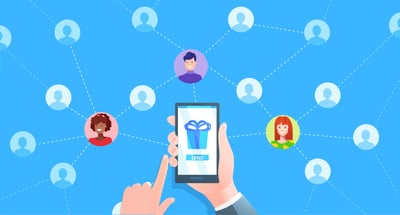September 19, 2023
 by Kirsty Sharman / September 19, 2023
by Kirsty Sharman / September 19, 2023

In today's competitive landscape, word-of-mouth remains one of the most powerful marketing channels around.
You have to harness its potential to expand your customer base and increase revenue.
In this blog post, we’ll explore the history of word-of-mouth marketing, discuss the ROI you can expect from a well-executed referral program, and take you through creating a referral program for your own business.
Word of mouth isn’t new to the scene.
The only real difference between now and in years gone by is how it happens. In the 1950s, a neighbor leaned over her garden fence and discussed the new range of shoes that just arrived at the local boutique. Fast forward to 2023, when users of a fast-growing music app share their referral links with friends in exchange for rewards from the app.
To understand how word of mouth has evolved over time, I'll share two of my favorite examples of happy customers spreading the word about brands they love.
You’ll notice that in both cases the message is being spread through digital channels.
By personalizing their product with individual names, Coca-Cola created a powerful emotional connection that led customers to spread the word.
If people purchased a Coke with a friend’s name on it, they would organically share that experience on socials. This is word of mouth in its simplest form.
Source: Referral Factory
Through incentivizing both referrers and new users with travel credits, Airbnb channeled the power of word-of-mouth marketing to rapidly expand its user base.
"Share the love of travel with your friends and get a discount on your next trip in return" sounds like a winning referral strategy to me!
Source: Referral Factory
These real-world examples demonstrate how brands can steer word-of-mouth marketing strategies to drive growth and establish strong customer relationships.
So naturally, the next question is, “How can you unlock the power of word of mouth for my own brand?”
The answer is simpler than you think!
First, you need to offer a great product or service to your customers, and this is something you can’t fake. People won’t recommend your business to their friends if they don’t feel you deserve the recommendation – no matter how great the reward.
If your average review score on G2 holds steady above 3.5, then you can consider your brand ready to ask for referrals. If it’s lower than 3.5, then work on your brand offering and service first before asking for referrals.
Once your brand image is high enough, it’s time to launch a referral program!
Identifying the specific actions or behaviors that constitute a successful referral is the first thing you need to decide when creating your referral program.
When it comes to your company, what are your customers actually telling their friends to do? Your base might tell their circle to make a purchase, sign up for a subscription, or book a demo.
Determining what a converted referral is, clarifies the goals of your referral program so that you design all your campaign assets toward that goal.
Source: Referral Factory
Single-sided and double-sided referral programs each have their own advantages and considerations.
A single-sided program only rewards the referrer. This is simpler to set up and manage but may result in lower conversion rates because the potential customers aren’t getting as much incentive to participate.
On the other hand, double-sided programs offer rewards to both the referrer and the referred customer. While these programs require more resources to implement, they generate higher engagement and encourage greater word-of-mouth promotion.
When deciding between single-sided or double-sided referral programs, consider your target audience's preferences, budget constraints, and desired conversion rates. A single-sided program may be more suitable if simplicity is important or if you work with limited resources.
However, if generating high levels of participation and motivation among your customers is a priority for your business goals, a double-sided program could provide stronger incentives for referrals.
Remember that every business is unique; what works well for one company might not work as effectively for another. Carefully evaluate your specific circumstances before making a decision on whether to implement a single- or double-sided referral program strategy.
Source: Referral Factory
You know your customers best, which means you’re most likely to know what kinds of rewards and incentives will drive the most amount of participation in your referral program.
The three most popular rewards are:
To tailor incentives accordingly, research different types of reward and analyze what motivates your customers to refer others. Design an appealing reward system that provides value and stays within budget.
Source: Referral Factory
You can build a referral program from scratch or work from a series of templates or no-code tools. You’ll need to create separate pages for the person referring and the people they invite.
While you’re developing your program, think about the email notifications that each user gets and how they’ll track their referrals. These kinds of referral tools can be found on G2, rated by real customer reviews.
Source: Referral Factory
Once your referral program starts working, be sure you have systems and automations in place so you don’t overload your team with manual work managing all the aspects of your program: from new referred leads to issuing rewards to reporting on the program’s performance.
If you use a CRM tool, integrate your referral program into the workflows you already use and the communications you already send. By syncing each user's referral link to your CRM, you’ll make it easy for your marketing, sales, and support team to actively ask for referrals when they interact with customers.
Source: Referral Factory
The biggest mistake companies make when they launch referral programs going too big too soon. Your referral program is like any of your other marketing campaigns in that it will improve over time as you adapt it based on performance.
This is why it’s important to begin small – ask 10% of your customers to refer a friend and see how it goes.
Only scale your referral program once you’ve seen how users participate with it, figured out how your processes work when a lead comes in, and decided how you’re going to correct the mistakes you made during round one.
Source: Referral Factory
Now that you’re up and running, it’s time to think about how to get referrals by promoting your program.
In this step, we’ll cover how you can create awareness so that people know which reward they’ll get for referring a friend! Hyping up your referral program can take many forms, but let’s discuss the most effective channels.
Send an email to your customers that asks them to spread the word about your business. You can either suggest that people opt into your referral program by registering, or you can generate referral links for them and issue them via email.
Either way, email is a great tool for announcing your referral program far and wide!
Source: Referral Factory
Your website is another asset you can call on to get referrals. By promoting your program on your website through widgets and pop-ups, you can turn your valuable web traffic into advocates for your brand.
Source: Mottiv
Tip: If you’re a retail business without much web traffic, use your office or store to advertise your referral program. A simple poster with a QR code linking to your referral page will serve your purpose.
Source: Referral Factory
You probably speak to your customers on at least a monthly basis through interactions like notification emails, logins, or invoicing. These are all opportunities to promote your referral program and remind people that you’ll reward them for sending new business your way.
Source: Referral Factory
Using a referral program template that matches your business type or campaign strategy gets your program up and running faster. You’ll also be using a referral strategy designed by an expert, meaning you’re more likely to succeed in the long run!
Templates are essentially pre-built referral programs that you copy and use as your own.
Source: Referral Factory
A referral program can lead to a significant increase in customer acquisition and higher customer lifetime value, boosting your overall growth potential.
Every industry is unique, so it’s hard to say exactly how many referrals you can expect when launching a referral program, but there are benchmarks you can use to forecast how many you can expect to generate by adding referral marketing to your overall growth strategy in 2024.
Source: Referral Factory
The biggest factors that will influence the ROI you get from your referral program are:
The more customers and fans you ask to refer, the higher your success rate will be. It takes new businesses longer to get their referral programs off the ground because they need time to build up their base.
It’s not about how good your reward is.
By adding a great incentive to your referral program, you actually make the person referring feel more motivated to share their referral link. If people feel they’re giving their friends a deal rather than selling your product or service, they’ll be much more likely to share their referral links with friends. It also motivates the invitee to convert faster because they don’t want to miss out on this special offer in the future!
This is one of the few metrics you can’t fake. If you have a great business that makes customers happy, your referral program is likely to succeed.
If you’re not certain your business is ready to ask for referrals, look at your aggregate review score on G2. Anything above 4 stars, and you’ll find people are willing to spread the word about your business.
Identifying key performance indicators (KPIs) is crucial for tracking the effectiveness of your referral program. Set clear objectives and metrics so you’re always on top of your referral efforts.
One key metric is the number of referrals generated.
This can include the number of referrals existing customers make and the number of new customers you acquire through these referrals.
You should also keep an eye on the conversion rate of your referred leads/users. Monitor the percentage of referred customers who actually make a purchase or take a desired action. Referred leads usually convert twice as often as leads acquired through paid advertising channels.
Seeing things all the way through to conversion will help you see the true value of your referral program!
Source: Referral Factory
Referral software helps set you up with your referral program. There are several features to look for in referral program software. Consider software that offers mostly no-code functionality, giving you more control as a marketer managing a program.
Look for a referral marketing solution that offers at least these features:
Word-of-mouth marketing may not be new, but it’s definitely becoming a more interesting channel for marketers because of the explosion of no-code tools that will have you creating a referral program in just a few days.
Growing through referrals started as a hack for startups a decade ago, but fast forward to 2023, and we’re seeing businesses of all shapes and sizes launching referral programs to grow!
In the changing B2B landscape, learn how you can drive customer advocacy and understand the voice of the customer.
Kirsty Sharman is the founder of Referral Factory. She boasts an impressive career with over a decade of experience in technology and marketing, having consistently identified the latest consumer trends and built companies to address these needs. Prior to her current venture, she co-founded and built what is now Africa’s largest influencer marketing platform, Webfluential.
Referral marketing is an amazingly effective tool when employed correctly.
 by Derick Okech
by Derick Okech
Partnerships are no longer just a growth lever — they’re a core business strategy.
 by Sean Blanda
by Sean Blanda
Potential customers always ask their friends and family for recommendations before buying a...
 by Megan Mosley
by Megan Mosley
Referral marketing is an amazingly effective tool when employed correctly.
 by Derick Okech
by Derick Okech
Partnerships are no longer just a growth lever — they’re a core business strategy.
 by Sean Blanda
by Sean Blanda


